Posts Tagged ‘pet immunization’
What to Do Before Adopting a New Pet
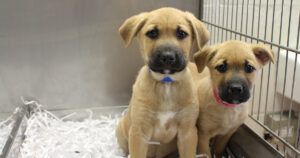 Adopting a pet is an exciting time for you and your family. However, it can be very overwhelming before your new furry friend comes home. Today, we will be discussing what you should do before your new pet comes to their forever home.
Adopting a pet is an exciting time for you and your family. However, it can be very overwhelming before your new furry friend comes home. Today, we will be discussing what you should do before your new pet comes to their forever home.
First, you should consider your current family. Do you have any other pets? How will they react to bringing in a new pet into the home? You also need to consider how your current home will serve for your new pet. Will your social life or work obligations affect your ability to care for this new pet? How do the other people you live with feel about having a new pet in the house? Are there any health issues that need to be accommodated? What kind of lifestyle do you want to live with your new pet? Are you looking for a dog to go running with or a cat to chill with? Are you in the position to train a pet with behavior issues or are you looking for a more relaxed pet experience? All these questions serve as a guide as to what kind, if any, pet you should adopt. If your current life is not suitable for a pet, maybe it’d be best to wait some time to where you will be more prepared to give your new pet the life they deserve.
More likely than not, the adopting agency will charge a fee to help mediate the costs of taking in unwanted or lost animals. This adoption fee will be a tiny fraction of money compared to how much money you will be spending over the life of your pet. You may also need to pay for your pet to be spayed or neutered before bringing them home. Some mandatory expenses of caring for a pet include food, veterinary care, licensing, collars/leashes/ID tags, cat litter, and grooming supplies. Other expenses that are highly recommended but not mandatory are permanent identification in the form of microchipping, training classes, professional grooming, spare supplies, beds, toys, crates, or carriers. There is also the chance that your furry friend will need emergency veterinary care which can get quite pricy. Before adopting a pet, it is important to make sure that you have the right financial state to be able to care and provide for your pet.
Before bringing your new pet home, you need to make sure that you will have the time to spend on taking care of your pet. Pets need to be fed two to three times a day. A pet parent should spend at least one hour per day giving direct attention to your pet in the form of training, exercising, grooming, or playing with them. A pet with a lot of energy will need more time to exercise and play with toys. Pets with long coats will need twenty minutes per day of grooming to keep their coat silky and not matted. Pets with medical conditions will also need extra attention. In the beginning of your adopted pet being home, they may need additional bonding and reassurance time in the first few weeks.
If you are completely prepared to give your pet the best life possible, the last thing you will need to supply are the necessary items for pet care. For dogs, these are food and water bowls, food, collars, leashes, ID tags, a bed, shampoo, nail clippers, brush/comb, poop baggies, toys, treats, and first aid supplies. For cats, they will need food and water bowls, food, kitty litter, collars, ID tag, carrier, nail clippers, brush/comb, toys, and first aid supplies. It could be best, however, to wait to see the size of your new pet for some of these items, as they will vary based on how big or small your new friend is.
Adopting a pet is an enjoyable yet stressful time in one’s life. Hopefully this list of preparation has made you feel more relaxed and prepared to bring your furry friend home. As always, feel free to contact Dr. Olsen at Olsen Veterinary Clinic at 618-656-5868 with any questions.
What Nutrients Does My Cat Need?
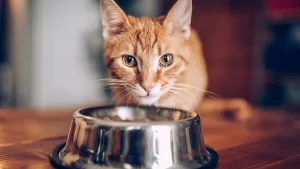 It can be hard to determine what nutrients you cat needs. There are so many options, and it can be very overwhelming. Each option says you need something different. What is the easiest way to give your cat all of the nutrients it needs?
It can be hard to determine what nutrients you cat needs. There are so many options, and it can be very overwhelming. Each option says you need something different. What is the easiest way to give your cat all of the nutrients it needs?
The simplest way is to make sure that your cat is being fed foods that have an Association of American Feed Control Officials (AAFCO) statement of nutritional adequacy on their labels. It could be something like the sentence, “Animal feeding tests using AAFCO procedures substantiate that Yummy Cat Food provides complete and balanced nutrition for adult maintenance, growth and reproduction, or all life stages” or “Yummy Cat Food is formulated to meet the nutritional levels established by the AAFCO Cat Food Nutrient Profiles for adult maintenance, growth and reproduction, or all life stages”.
Essentially, the AAFCO looks for the proper amounts of each nutrient to keep your cat happy and healthy. These nutrients involve lots of protein as cats are carnivores after all. Protein provides energy, maintain muscle, skin, fur, nails, etc. Cats need animal proteins because their bodies need the nutrients it provides. When a cat eats protein, their digestive tract breaks it down into amino acids, which are then reassembled into the type of protein that the cat needs at that time. Animal protein can be expensive, so some cat food manufacturers keep costs low by including only the minimum amount of protein that cats require to survive, not more to help them thrive. A cats crude protein level should be included in the guaranteed analysis section on the label. To bee nutritionally complete and balanced, AAFCO mandates that a cat food for adult maintenance contain a cat food for adult maintenance contain a minimum of 26% crude protein on a dry matter basis. The minimum for growth and reproduction is 30%.
Another important energy source for cats is fat. Fat and the related fatty acids are parts of ingredients like salmon, chicken, liver, or beef. Sometimes, extra fat is added to foods in the forms of beef fat, fish oil, or soybean oil. The AAFCO minimum for fat in all cat foods is 9% on a dry matter basis. Significantly higher levels of fat may be appropriate for cats who are highly active or have trouble maintaining their weight. Diets designed for weight loss will usually contain less fat in comparison to other foods.
Carbohydrates are less important for cats than they are for humans. A diet containing large amounts of carbohydrates is not natural for cats and may promote weight gain and related health problems. Ideally cats should get less than 10% of their calories from carbohydrates.
Vitamins are necessary in a cat’s diet. Sources include animal tissues, vegetables, fruits, vegetable oils, seeds, and grains. However, it is almost impossible to provide all the vitamins a cat needs at the right levels without including a vitamin supplement in the manufacturing process. If a cat is healthy and eating a nutritionally complete diet, additional vitamin supplementation is not necessary and can be dangerous in some cases. Be sure to discuss with your vet if you think your cat needs supplementation. Related, minerals are another important part of your cat’s diet to help your cat’s body function. Some of the minerals that cats need can come from animal and plant-based ingredients (bone meal, for example), but to be nutritionally complete and balanced, cat food manufacturers almost always must add mineral supplements to their formulas. As long as your cat is healthy and eating a good quality food, you shouldn’t have to add any additional supplementation.
The most important nutrient for cats is water. Water is essential for almost every one of your cat’s metabolic functions. Cats will typically let themselves get dehydrated before they seek out water, so water is necessary in their foods. Some ingredients, like whole meats, are rich in water. Water is also added to commercial cat foods as part of the manufacturing process to facilitate mixing. You may see this on the ingredient list as “water sufficient for processing.” Most of the water is subsequently driven out of dry foods to make them more shelf stable. Generally, cats need about 4 to 5 ounces of water per 5 pounds of body weight, but this includes both water from food and water bowls. Cats who eat canned food may only need to drink very little supplemental water.
If you are feeding your cat a good quality food, your cat is getting its essential vitamins and nutrients. To be even more certain, you can look for an AAFCO certification. As always, if you have any questions, feel free to contact Dr. Olsen at Olsen Veterinary Clinic, 618-656-5868.
Dr. Olsen’s Breed Spotlight: The Irish Wolfhound
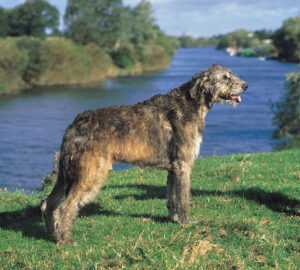 For this next breed spotlight, I will be introducing you to the Irish wolfhound, likely for the first time. This dog is calm, dignified, and the tallest breed of dog (sorry Great Danes). Early ancestors of Irish wolfhounds were fearless, big-game hunters who could dispatch a wolf in single combat. Today, they are the most serene and agreeable of companions.
For this next breed spotlight, I will be introducing you to the Irish wolfhound, likely for the first time. This dog is calm, dignified, and the tallest breed of dog (sorry Great Danes). Early ancestors of Irish wolfhounds were fearless, big-game hunters who could dispatch a wolf in single combat. Today, they are the most serene and agreeable of companions.
The amiable Irish Wolfhound is an immense and muscular hound. They are built along classic Greyhound lines, capable of great speeds at a gallop. A male might stand nearly three feet at the shoulder and can weigh up to 180 pounds. Females will run smaller but are still a very large dog. They have a rough and hard coat that can come in many colors. They can be white, gray, brindle, red, black, and fawn. Irish wolfhounds are way too serene to be fierce guard dogs, but the mere sight of the size of these dogs are enough to deter intruders. Irish wolfhounds are characteristically patient with kids, but their size does require supervision when they are around small children.
The history of this wolfhound goes back to the breeding of indigenous large dogs of Britain to the Middle Eastern coursing hounds that were bartered around the known world in the earliest days of international trade. By the time the Roman Empire had gained a toehold in the British Isles, the giant hounds of Ireland were already long established. In the year 391, the Roman consul received a gift of seven of these hounds that “all Rome viewed with wonder”. These majestic hunters, whose motto was “gentle when stroked, fierce when provoked”, were used on such quarry as the now-extinct Irish elk, a massive, ferocious beast said to stand six feet at the shoulder. In 15th-century Ireland, wolves were overrunning the countryside. The Irish hounds, already renowned big-game hunters, began to specialize on wolves. By the late 1700s, when wolves and other big-game animals of Ireland were hunted to extinctions, Irish wolfhounds lost their job and nearly went extinct themselves. This is a case of a breed doing its job too well for its own good. In 1862, British army captain George Augustus Graham began scouring the country for remaining specimens of Ireland’s national hound. Graham made it his life’s work to protect, standardize, and promote the breed. Today, his name is still spoken with reverence wherever Irish wolfhound fanciers gather.
The coats of Irish wolfhounds have two layers; the outer being harsh and wiry with the under being very soft. They shed throughout the year, but not in an excessive amount. Unlike many other double-coated breeds, Irish wolfhounds don’t “blow out” their coats during an annual or semi-annual shedding season. Irish wolfhounds retain a strong instinct to hunt and chase prey, so they should only be allowed off the leash in areas that are securely fenced. As adults, Irish wolfhounds can become couch potatoes if allowed to, but regular exercise like long walks and play sessions help keep them physically and mentally healthy. A home with a large, fenced area is necessary to provide the environment needed for this breed to thrive. The breed can also exercise mind and body by participating in canine sports like tracking, agility, and lure coursing.
These gentle giants are sure are a breed with a rich history. Their ancestors’ traits reveal themselves with their passion for hunting and need for mental and physical exercise. Generally, these dogs make excellent companions for anyone with enough land to satisfy their need to run. With any questions, please feel free to contact Dr. Olsen at 618-656-5868.
What to Do to Keep Your Dog Cool This Summer – and What NOT to Do
 Keeping your dog cool during the summertime is difficult yet very important. The most important thing to remember is having plenty of fresh, cold water available for your pup. Whether it is just for playing in the back yard or going on a long hike, be sure to keep fresh, cold water available and accessible for them. When you are out on the go, bring a collapsible water bowl or a squirt bottle. Give your dog small amounts of water every 15 to 20 minutes. Be sure to have enough cool water with you to last the entire time you’re gone. If your dog starts panting excessively, get your dog shade and more water right away.
Keeping your dog cool during the summertime is difficult yet very important. The most important thing to remember is having plenty of fresh, cold water available for your pup. Whether it is just for playing in the back yard or going on a long hike, be sure to keep fresh, cold water available and accessible for them. When you are out on the go, bring a collapsible water bowl or a squirt bottle. Give your dog small amounts of water every 15 to 20 minutes. Be sure to have enough cool water with you to last the entire time you’re gone. If your dog starts panting excessively, get your dog shade and more water right away.
Similarly, an easy way to keep your dog cool while spending summer outside is to play in the water. A wet dog is a cool dog. You can play with your pooch in sprinklers, pools, and lakes. Swimming can help lower your dog’s body temperature and help them stay cool while having fun.
While there are things you can do to keep them cool, there are also things you should NEVER do. The biggest rule is to never leave your dog in a parked car, even with the windows cracked. Even on milder days, temperatures inside your car can quickly rise to dangerous and life-threatening levels. The CDC says that cars parked in direct sunlight can reach internal temperatures up to 131ºF-172ºF when it is 80ºF-100ºF outside. These temperatures are extremely dangerous, and your dog should never be subjected to it.
Also, avoid being outside with your dog during the midday heat. It is ok to be outside with your dog on mild, overcast days with low humidity. However, if it is sunny, 80º and high humidity, it is better to avoid the midday heat. On days like these, go early in the morning or later in the evening when it is not as hot. It is important to remember the danger of asphalt during the summer. Asphalt can get extremely hot in direct sun. Put your hand on the pavement to test the temperature. If it is too hot for your hand, it is too hot for your dog. You can also pour some water on the pavement. If it steams, it is way too hot. You can buy booties for your dog, so their feet are not on pavement, but it is easiest to avoid it all together. It is best to find trails. Because they aren’t hard surfaces and typically shaded, they’re less likely to cause injury.
During the summer, it is very important to know the signs of heatstroke in dogs. Pay attention to your dog’s behavior, body language, and more. Symptoms of heatstroke include excessive panting, excessive salivating, obvious discomfort, vomiting, diarrhea, disorientation, and seizures. If you notice any of these symptoms, get your dog to a cooler environment as soon as possible and calling your veterinarian for further instructions. You can use a thermometer to check their body temperature. If it is above 104º, it is time to get them out of the sun and decrease the level of activity. 104º is not dangerous, but it is the threshold to where it could become dangerous. When your dog’s temperature stays elevated, even after stopping activity and getting out of the heat, this is a sign that you need to intervene and call your vet. Please feel free to contact Dr. Olsen at Olsen Veterinary Clinic at 618-656-5868 with any questions.
Cat Adoption Checklist
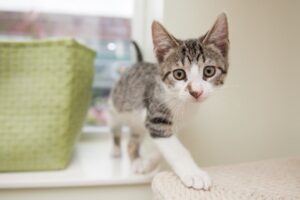 After deciding to adopt a cat, there is plenty to be done. It can seem overwhelming, but hopefully this quick checklist will provide you with information on how to best prepare for your new furry friend.
After deciding to adopt a cat, there is plenty to be done. It can seem overwhelming, but hopefully this quick checklist will provide you with information on how to best prepare for your new furry friend.
Prepare a cat room or area.
One of the most important things your cat needs is a quiet, cozy, and secluded space that your cat can consider their own. It can be a spare bedroom or a corner of your living room. This will make sure your cat becomes familiar with their space before exploring the rest of their home.
Remove any hazards.
Look for strangle hazards such as the cords to blinds, tassels, and drapes. Cats are notoriously curious, so they will play with anything they can find. Similarly, make sure any other hazards like cords, rubber bands, or other small items are not accessible to your cat. Hide any chemicals so your cat is not tempted to drink or lick them. Lastly, remove any toxic plants.
Provide access to a high spot.
Buy having a high spot, cats can view their surroundings with ease. A simple cardboard box in a high place will do the trick but you can buy fancier products. One example is a cat hammock that attaches to your window with suction cups.
Provide your cat plenty of hiding spots.
All cats enjoy hiding places. This can be in a cardboard box, under furniture, or even a cat tree. Do not be alarmed if your cat hides for most of the day when you first bring them home. Just make sure they are eating, drinking, and defecating regularly and give them time to adjust to their new home.
Buy cat products.
This involves a food bowl, water bowl, cat food, a soft bed, a litter box, cat litter, a scratching post, a brush, a cat carrier, and stimulating cat toys.
When adopting a cat, the prep work can seem overwhelming. Hopefully this checklist provided some clarity on what you can do to provide the best home for your new furry friend. As always, feel free to contact Dr. Olsen with any questions at 618-656-5868.
What You Need To Know About Pet Poisons
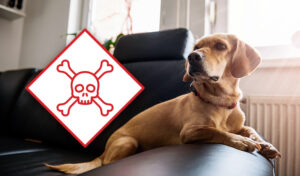 No pet owner wants to hurt their furry friend, but sometimes it is inevitable. Accidental poisonings can be prevented with simple switches in your home. One of the easiest ways to prevent an accidental poisoning is to watch what you plant in and around your house. While plants provide clean air for you home, they can also be really dangerous for pets based on what types of plants they are. Plants that aren’t toxic to humans like the hibiscus, those in the Easter lily family, mistletoe, and Dieffenbachia can cause medical problems in pets. Issues such as renal failure, irregular heartbeats, cardiac shock, or even death. Other examples of toxic plants include azalea, oleander, castor bean, sago palm, rhododendron, and Japanese yew. If you have these plants and cannot stand to give them up, put them up high in an unreachable location where your animal cannot chew or dig them up
No pet owner wants to hurt their furry friend, but sometimes it is inevitable. Accidental poisonings can be prevented with simple switches in your home. One of the easiest ways to prevent an accidental poisoning is to watch what you plant in and around your house. While plants provide clean air for you home, they can also be really dangerous for pets based on what types of plants they are. Plants that aren’t toxic to humans like the hibiscus, those in the Easter lily family, mistletoe, and Dieffenbachia can cause medical problems in pets. Issues such as renal failure, irregular heartbeats, cardiac shock, or even death. Other examples of toxic plants include azalea, oleander, castor bean, sago palm, rhododendron, and Japanese yew. If you have these plants and cannot stand to give them up, put them up high in an unreachable location where your animal cannot chew or dig them up
Your cat may love to snack on some grass outside, but this grass can be loaded up with deadly fertilizers and pesticides. Instead, you could make an indoor mini lawn for your cat. Mini lawns provide a safe, edible source of greenery. Special feline gardens are available commercially or you can start your own kitty garden using a bowl, soil, and grass seed. You could also grow catnip for you cat, but make sure to monitor how much your cat chews. While catnip is not generally toxic for cats, too much of the plant can overstimulate your cat’s central nervous system and cause a cat to injure themselves.
If you find that your pet was chewing on a plant, immediately remove the plant from their mouth and rinse their mouth gently with water. Identify which plant your pet was eating and call the poison center or your veterinarian. Be sure to watch for excessive or foamy salivation and changes in the skin around the mouth, eyes, or paws.
Another common cause of accidental poisonings is giving your pet something intended for a human. This could include people food, chemicals, or even medications. People often make the mistake of thinking that people food is ok for pets. Sometimes it is and sometimes it is not. Be sure to avoid milk, bones, chocolate, onions, rich and fatty foods, grapes, raisins, coffee, nicotine, and alcoholic beverages.
Like a child, one should poison-proof their house. Be sure to keep the cleaning products in a high, closed cabinet. There should be nothing below counter level because liquid drain cleaners, as well as tub and tile cleaners, can be lethal. Be sure to take precautions in the garage as well. Insecticides and auto care liquids need to be store high off of the ground to keep your pets from getting into them. Accidental chemical poisonings can even be made in giving medication. Avoid this by reading the label. For example, be sure to read the labels of flea control for your pets because the chemicals in dog flea agents are lethal for cats. Be sure to read the label directions and amounts carefully.
Some pet owners think that human medication will work for pets. This is incorrect. Never give your pet a human medication without consulting with your veterinarian. Even something as simple as aspirin can be lethal to your pet. Products such as acetaminophen and any aspirin product can cause stomach bleeding. Products like birth control and vitamins can also cause internal bleeding.
Cats tend to be attracted to unusual flavors. Be sure to keep things like the calamine lotion, diaper cream, sunblock, etc. away. These products contain an acid related to aspirin in them and will be toxic if ingested. Overall, small actions you take can help prevent the poisonings of your pets and keep them health. If you have any questions, feel free to contact Dr. Olsen at Olsen Veterinary Clinic at 618-656-5868.
What You Need To Know About Canine Flu Season
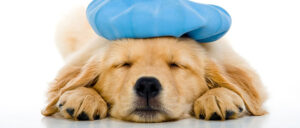
Canine influenza is a highly contagious viral infection that affects dogs and cats. Influenza viruses are able to quickly change and give rise to new strains that can infect different species. Of the two strains identified in the US, both of them can be traced to influenza strains known to infect species other than dogs. At some point, these viruses acquired the ability to infect dogs and be transmitted from dog to dog. Virtually all dogs exposed to canine influenza become infected, with approximately 80% developing clinical signs of disease. The other 20% of infected dogs that do not exhibit clinical signs of the disease can still shed the virus and spread the infection.
Canine influenza is transmitted through droplets or aerosols containing respiratory secretions from coughing, barking, and sneezing. Dogs in close contact with infected dogs in places like kennels, groomers, day care facilities, and shelters are at an increased risk of infection. Canine influenza can be spread indirectly through objects like kennels, food and water bowls, collars, and leashes or people who have been in contact with an infected dog to avoid exposing other dogs to the virus. Due to this, people in contact with an infected dog should wash their hands and clean their clothing to avoid spreading the virus. The virus can stay alive and able to infect on surfaces for up to 48 hours, on clothing for 24 hours, and on hands for 12 hours. It is important to implement cleaning and disinfection procedures to reduce the risk of disease transmission.
The majority of infected dogs exhibit the mild form of canine influenza. The most common clinical sign is a cough that persists for 10-21 days despite treatment with antibiotics and cough suppressants. Affected dogs may have a soft, moist cough, or a dry cough similar to that induced by kennel cough. Nasal and/or ocular discharge, sneezing, lethargy, and anorexia may also be observed. Many dogs developed a purulent nasal discharge and fever. Some dogs are more severely affected and exhibit clinical signs of pneumonia, such as a high-grade fever and increased respiratory rate and effort.
Canine influenza cannot be diagnosed solely by clinical symptoms like coughing, sneezing, and nasal discharge because these signs also present with other canine respiratory illnesses. Tests must be done to properly identify strains of canine influenza virus. Contact Dr. Olsen to set up a test if you think that your dog may be infected.
Treatment for canine influenza is largely supportive. Good nutrition helps dogs mount an effective immune response. Most dogs recover from canine influenza within two to three weeks. Secondary bacterial infections, pneumonia, dehydration, or other health factors may require additional diagnostics and treatments.
While canine influenza is a serious threat, vaccines are available against both strands of canine influenza found in the US. Vaccination can reduce the risk of a dog contracting canine influenza and while it may not all together prevent an infection; it may reduce the severity and duration of illness. As always, feel free to contact Dr. Olsen at 618-656-5868 with any questions or to set up an appointment!
Kennel Cough: What You Need To Know
 Doggy daycare, like regular daycare, can be a cesspool of different germs and infections. If your dog comes home from daycare with a strange cough, your dog might have contracted kennel cough. Kennel cough can be caused by a variety of different viruses and bacteria. Kennel cough is caused by a dog inhaling bacteria or viruses into their upper respiratory tract. Symptoms can be worsened if their lungs are already overworked by cold air, cigarette smoke, stress, or crowded quarters with poor ventilation.
Doggy daycare, like regular daycare, can be a cesspool of different germs and infections. If your dog comes home from daycare with a strange cough, your dog might have contracted kennel cough. Kennel cough can be caused by a variety of different viruses and bacteria. Kennel cough is caused by a dog inhaling bacteria or viruses into their upper respiratory tract. Symptoms can be worsened if their lungs are already overworked by cold air, cigarette smoke, stress, or crowded quarters with poor ventilation.
The respiratory tract is usually lined with mucus which helps trap particles that might cause infections which is why kennel cough is often caused by multiple different pathogens – one weakens the mucus in the lungs allowing the other to take root and cause infection. Kennel cough is extremely contagious and spreads around the environment where other dogs inhale the pathogen and become sick. Kennel cough is difficult to control since it is airborne. The main symptom of kennel cough is a cough that sounds like a goose honk. Some dogs will only experience coughing with kennel cough while others may have other symptoms such as sneezing, a runny nose, or eye discharge.
Severe symptoms may include retching, lethargy, and fever. Usually kennel cough lasts for three to four weeks with the worst symptoms in the first five days and dwindling over time. Young puppies and older dogs with weakened immune systems are more susceptible to kennel cough and can take up to six weeks to recover. Stress and environmental factors like temperature, dry climate, and airborne irritants like smoke can increase the severity of prevalent symptoms.
Vaccines for kennel cough are extremely important as they can reduce the odds of getting it or reduce the symptoms. While the vaccine is not 100% effective, it can greatly reduce the odds of your dog contracting the illness if they is frequently in conditions that tend to spread the disease, such as daycare. The vaccine is typically offered in oral, intranasal, and injected forms. The biggest mistake believed by some is that kennel cough is a minor issue that doesn’t call for a trip to the vet. While it may seem like a minor problem, kennel cough can lead to pneumonia or death, especially in dogs that already have weakened immune system.
It’s better to be safe than sorry and take your dog to the vet at the first signs of kennel cough, rather than waiting for the issue to progress. Your vet will be able to tell you how severe of a treatment needed to help your pets kennel cough. A mild cough may only need rest and a cough suppressant while severe kennel cough may require antibiotics or supportive care. Coughing is not only indicative of kennel cough; it may also indicate major health issues such as a collapsing trachea, canine distemper, canine influenza, bronchitis, asthma, or even heart disease. It is always best to err on the side of caution and bring your dog to the vet at any sign of coughing.
There are several home remedies that may help soothe your pet’s symptoms and reduce discomfort. Create a humid environment by using a humidifier or turning on a hot shower and putting your dog in the bathroom with the steam. Some dog owners have found that a small amount of honey daily can help a dog’s throat. Honey has natural antimicrobial and anti fungal agents that can reduce inflammation and soothe sore throats. Thus, reducing coughing while helping your pup fight off infection. Simply give your dog a spoonful of raw honey a few times a day. As always, be sure to check with your vet before introducing human food into your dog’s diet. Another option to consider is CBD oil. It is natural found in hemp plants and highly regarded for its health benefits. The anti-inflammatory properties of CBD oil can ease pain and swelling, restoring comfort.
Kennel cough is not a common cold. It is best to visit your veterinarian right away to learn of the best treatment path. As always, feel free to contact Dr. Olsen at 618-656-5868 with any questions or to set up an appointment.
Dr. Olsen’s Breed Spotlight: The Peruvian Inca Orchid
 The Peruvian Inca Orchid is not a flower, but a hairless sighthound that developed in Peru. The breed can be hairless or coated and can be found in a range of sizes. These dogs are good hunters and do well in agility. In the hairless variety, the skin can be of any color. The coated variety features all colors as well including black, brown, pink, tan, and white. On a sunny day, Peruvian Inca Orchids require sunscreen because of their exposed skin.
The Peruvian Inca Orchid is not a flower, but a hairless sighthound that developed in Peru. The breed can be hairless or coated and can be found in a range of sizes. These dogs are good hunters and do well in agility. In the hairless variety, the skin can be of any color. The coated variety features all colors as well including black, brown, pink, tan, and white. On a sunny day, Peruvian Inca Orchids require sunscreen because of their exposed skin.
The ancient history of the Peruvian Inca Orchid can be told through pottery and textiles. The breed first appeared in Moche pottery in 750 AD. The Chancay people used the dogs as companions, and certain pottery even depicts them in sweaters. The Chimu considered them good luck and used the dogs’ warmth for the treatment of arthritis and respiratory conditions.
The original hairless dogs were small companion animals, but when Peru was conquered by the Conquistadors, the small dogs were interbred with the dogs of the foreigners and over the years, three distinct sizes developed. In the mountainous regions, the Andean people protected the dogs, but the breed did not fare well in the cities along the coast. There, the hairless dogs were considered diseased and were often exterminated.
In 1966, an American, Jack Walklin, visited Peru and brought eight dogs back to the US. He is believed to be the one to have named the breed the Peruvian Inca Orchid and the breed was established under that name in the US and Europe. In 2001, Peru declared the breed a National Patrimony and the dogs are now protected in Peru.
Peruvian Inca Orchids come in a range of sizes with the smallest standing just short of 10” and the largest topping out at 26”. The distinguishing feature of a Peruvian Inca Orchid is their hairlessness. Their skin can be a solid color or spotted with unpigmented areas. Peruvian Inca Orchids that are coated are in the minority and can occur in the same litter with hairless Peruvian Inca Orchids.
Peruvian Inca Orchids are slim dogs who are very noble and affectionate to those close to them. At the same time, Peruvian Inca Orchids are lively, alert, and can be wary of strangers. Peruvian Inca Orchids make good watch dogs. Peruvian Inca Orchids are loyal and protective of their family but like all dogs should be supervised around children. If you have small pets, the Peruvian Inca Orchid might not be the dog for you as Peruvian Inca Orchids might mistake your small pet as prey.
What To Do If Your Dog Gets Into A Fight With Another Dog
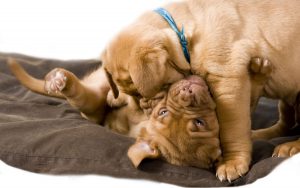 Dogs often wrestle and playfully bite each other. It’s just part of puppy play time. Sometimes, the wrestling turns into a full-blown dogfight. If the fight doesn’t seem to show signs of stopping, it’s important to step in before one of the dogs get hurt.
Dogs often wrestle and playfully bite each other. It’s just part of puppy play time. Sometimes, the wrestling turns into a full-blown dogfight. If the fight doesn’t seem to show signs of stopping, it’s important to step in before one of the dogs get hurt.
Most dogfights only last for a few seconds. It’s important to stay calm and clear headed. Resist the urge to grab your dog by the collar. It might be your first impulse, but when dogs are really fighting, they may whip around and instinctively bite your hand without any past aggression. You are able to tell that it’s a real dogfight when the dog’s bodies are rigid. To stop the fight, make as much noise as possible. You can yell, shriek, stomp your feet, clap your hands, etc. Do whatever you can to attract the dogs’ attention. Similarly, you can use water to get their attention. You can douse the dogs with a hose, bucket of water, etc. (If you are going to a new dog park or unfamiliar place, bring a spray bottle just in case a fight breaks out.) You can also use a barrier such as a large piece of cardboard, plywood, even a big stick to split them up. The large barrier acts as a way to split them up without risking your hands. Lastly, you can throw a blanket over the dogs. Some dogs will stop fighting when they can’t see each other anymore.
It’s important to know when you should step in. Scuffles between dogs last only a few seconds and can appear worse than they actually are. Fights involving fighting breeds should be stopped as they have trouble reacting to social signals from other dogs. Fights between dogs of two very different sizes or two females in heat will need to be broken up; as well as fights involving dogs who are known to have done physical harm in the past or will not walk away. Under no circumstances should you get between the two dogs. You can grab your dog from behind and grab the top of its hind legs, so it is in a wheelbarrow position. You can then walk backwards circling to one side so the dog will not be able to turn and bite you. After you stop the fight, be sure to separate the dogs and keep them out of each other’s sight. This prevents the chance that the two dogs may start fighting again.
To ensure that fight never happens, observe how your dog interacts with other dogs. Does your dog bark, pounce, and snap at other dogs? Do they play rough normally? If you know how your dog acts normally, you will be able to know when a fight is getting ready to begin. When dogs play, it often sounds a lot like it does when they’re fighting. Dogs will growl, snap their jaws, and bite one another roughly. Instead of listening, watch the dogs’ bodies. If they look loose and relaxed, and they’re wagging their tails, they’re probably just playing. However, if the dogs’ bodies appear stiff and rigid, and their tails are down, they may get ready to fight. If one dog thinks it is play time and the other isn’t seeing it as fun, it is best to separate them to avoid any fighting. To further prevent fighting, don’t encourage competition. Dogs get territorial over food and toys. Some breeds are more apt to defend their rights to beloved possessions while some are more apt at sharing. Be sure to know your dog’s unique personality traits so that they can prevent a battle from happening when another dog comes around. You can put treats, food, and toys away when your dog is having social time with another dogs and feed multiple dogs in separate rooms.
Preventing fights start from when the dogs are young puppies. Teach them to play nicely. Use positive reinforcement to reward good behavior. When your dog bites, growls, or exhibits other violent behavior, separate them from the dog that they are playing with and put them in time out until she calms down. Similarly, make sure that your dog knows to come when they are called. If your dog is good at obeying your call to come, you’ll be able to pull them out of tense situations before a fight may start.
As always, feel free to contact Dr. Olsen at Olsen Veterinary Clinic by calling 618-656-5868.
